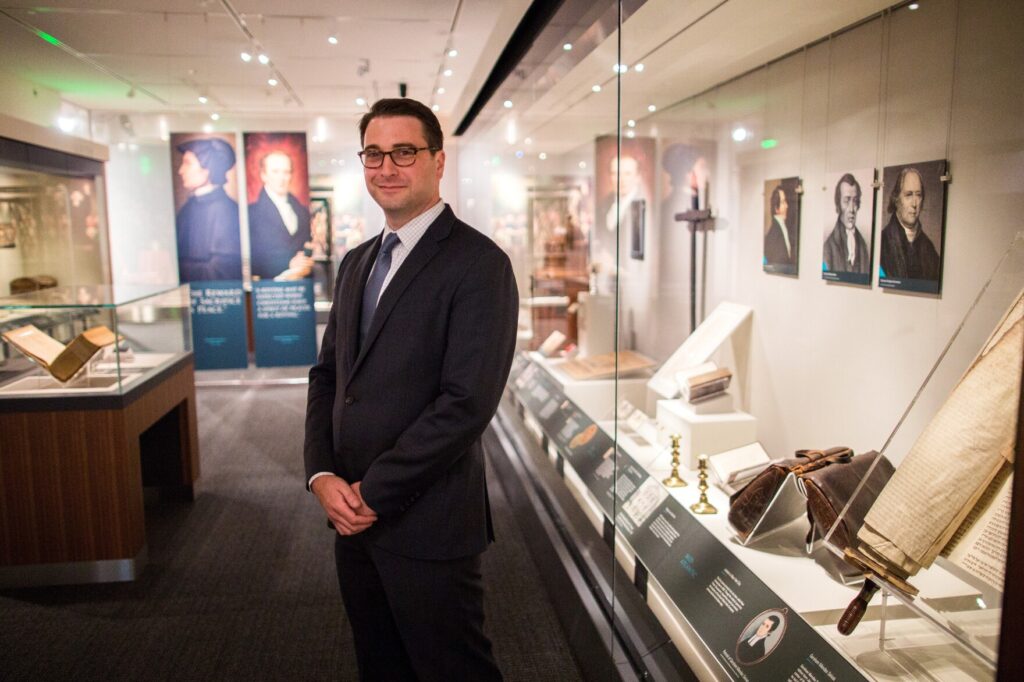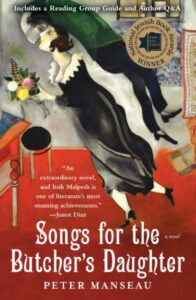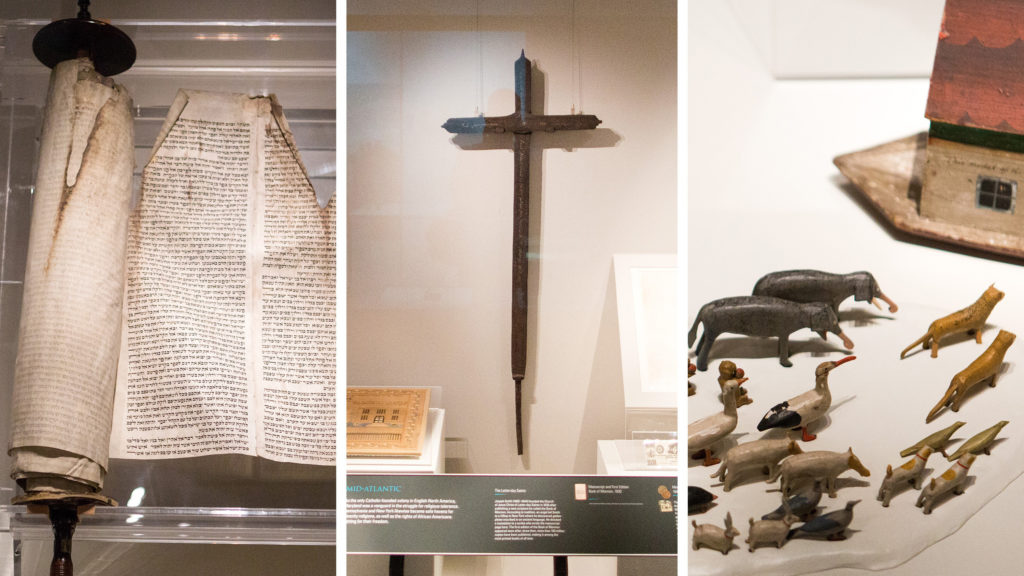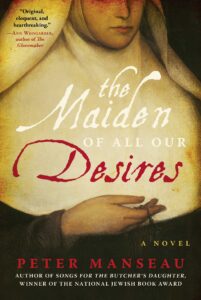Translating Religion for the Masses
A conversation with Peter Manseau about his newest novel, his work on religion at the Smithsonian, and his writing career

(Image source: Liam James Doyle for NPR)
You have likely read something by the prolific writer Peter Manseau. If not, let me introduce him: Manseau holds a Ph.D. in religious studies and is the author of two novels, a memoir, a travelogue, several additional nonfiction books, and countless articles in publications like the New York Times and the Washington Post. He is also the (first ever) Curator of Religion at the National Museum of American History and Director of the Smithsonian’s Center for the Understanding of Religion in American History. His career is inspiring; it provokes wonder at his vast abilities and, if I’m honest, some small envy — who wouldn’t want to go to work at the Smithsonian every day!
Running throughout Manseau’s impressive body of work is a longstanding interest in stories about religion. Manseau co-founded our comrade online publication, Killing the Buddha, along with the Revealer’s founding editor, Jeff Sharlet. Manseau has also written multiple pieces for the Revealer. Even the most cursory search through the Revealer’s archive (though I recommend doing more than a cursory search of his Revealer writings), brings to the surface myriad kinds of work. He has contributed everything from translations of Yiddish poetry to an excerpt from his memoir, and it would seem we rarely published an “In the News” round-up without mentioning something he had accomplished. In truth, I have been a fan of Manseau’s work since I first started writing about religion, but I had never had the chance to sit down with him for a one-on-one exchange. But last month I read Manseau’s impressive and enthralling new novel, The Maiden of All Our Desires, which gave us an occasion to have a conversation about his remarkable career and how his new novel, a story about a 14th-century convent during the Black Plague, came to life.
Kali Handelman: First, I’d love to give readers a sense of the breadth of your work — in particular how the particular strands all fit together and inform one another. It seems to me that all of your work is concerned with storytelling, and I wonder if you could tell me more about how you think about storytelling — what makes it important and how do you approach it across these multiple forms of work?
Peter Manseau: When I wake up in the morning I rarely know exactly what’s going to occupy my mind through the day. My nine-to-five working hours are usually reserved for my day job (for the last six years as the Curator of Religion at the National Museum of American History, and now additionally as Director of the museum’s Center for the Understanding of Religion in American History), but I also tend to have a few books going at various stages of development, ranging from projects well underway to ideas I know I shouldn’t be thinking about until I move a few other things off my plate, as well as occasional op-eds and essays I write because putting a short piece out in the world can (momentarily) feel more satisfying than chipping away at a long manuscript for years on end.
In general, I’m drawn to stories first and then decide what format will be best for their telling, whether it’s an exhibition or a novel, a narrative nonfiction history, or a shorter essay. In that sense, yes, storytelling does pull the strands of my work together. But to be more precise about it, I tend to see the type of storytelling that most often engages me as a form of translation, serving as a bridge that allows certain narratives and information to reach audiences that might not otherwise have access to them.
 In my Smithsonian work and historical writing, this is often translating scholarship for the general public, such as in the recent exhibit Discovery and Revelation, which distills the shifting paradigms of scholarly discourse on science and religion into a 1,200 square foot collection of objects and images geared toward tourists and school groups, or in my 2015 book One Nation Under Gods, which shares stories about the out-sized influence of minority religious groups in America that are totally non-controversial in academic history (the existence of Muslims in vast numbers among the U.S. enslaved population, for example) with audiences for whom they are entirely new and (I hope) revelatory. I have also explicitly made the various meanings of “translation” a theme in some of my work, as in my 2008 novel Songs for the Butcher’s Daughter, which is presented as a translated Yiddish text studded with “translator’s notes” that become part of the story, and my 2009 travelogue Rag and Bone, which explored the role of religious relics in various traditions. In Christianity, the movement of relics from one site to another is sometimes known as “translation,” drawing on the original Latin sense of a word meaning “to carry across,” the literal movement of a sacred object across a threshold from an inner sanctum to the broader world. Those two books are now more than a decade old, but that’s still how I see much of my work.
In my Smithsonian work and historical writing, this is often translating scholarship for the general public, such as in the recent exhibit Discovery and Revelation, which distills the shifting paradigms of scholarly discourse on science and religion into a 1,200 square foot collection of objects and images geared toward tourists and school groups, or in my 2015 book One Nation Under Gods, which shares stories about the out-sized influence of minority religious groups in America that are totally non-controversial in academic history (the existence of Muslims in vast numbers among the U.S. enslaved population, for example) with audiences for whom they are entirely new and (I hope) revelatory. I have also explicitly made the various meanings of “translation” a theme in some of my work, as in my 2008 novel Songs for the Butcher’s Daughter, which is presented as a translated Yiddish text studded with “translator’s notes” that become part of the story, and my 2009 travelogue Rag and Bone, which explored the role of religious relics in various traditions. In Christianity, the movement of relics from one site to another is sometimes known as “translation,” drawing on the original Latin sense of a word meaning “to carry across,” the literal movement of a sacred object across a threshold from an inner sanctum to the broader world. Those two books are now more than a decade old, but that’s still how I see much of my work.
KH: Your work is also deeply interested in history and how historical stories are told. When we spoke, you told me that you are interested in questions of who is remembered and who is forgotten, and similarly, who is taken too seriously and who isn’t taken seriously enough. I wonder how that perspective on the historical has informed your museum work?
PM: Long before I knew I’d be a writer or a museum curator, I wanted to be an archaeologist. From my first viewing of Raiders of the Lost Ark when I was six years old, I had romantic notions about what that work must entail – notions that weren’t really dispelled until I became an archaeology major in college and discovered how far the reality of that occupation was from my fantasy of it. But what I learned in that disillusionment was what I was really interested in was the possibility that there were mysterious mystical treasures buried all around us. What I wanted was to uncover those treasures, to make contact with those mysteries. I approach all my work now in much the same way. The stories we take for granted, and which all our assumptions rest upon, are the ground beneath our feet. But the ground can be deceiving. We tend to see an empty field and think it has always been an empty field. To find out otherwise you either need to ask questions or you need to dig; both are acts of uncovering things that once were obvious but over time became obscured. In all my work – as a novelist, a historian, a curator — I see my role as bringing those kinds of things to light. Very often this means the stories of people left out of most tellings of history – people on the margins whose experiences are dismissed, discounted, forgotten.

(Objects from the National Museum of American History. Image source: James Doyle for NPR)
In my museum work this has meant paying attention to what it means for communities or individuals to leave behind a material record that endures long enough to be studied or displayed. Though I’m drawn to the “stuff” of both religion and history, it’s also important to keep in mind that relying exclusively on objects can inadvertently limit the stories we’re able to learn and tell. Equally important to making use of material culture is paying attention to its absence, finding ways to tell the stories of those who have not had the privilege of leaving anything behind.
KH: So much of your work has been consistently interested in religion — from your academic training, to your news articles, to your memoir and your novels, and of course, your role at the Smithsonian. You told me at one point that thinking about religion is especially fruitful because it’s about taking seriously (to carry that through) the stories (to carry that through) people tell themselves. I wonder if you could elaborate on what that means as a kind of working definition of religion — religion as a way of understanding and thinking about the stories we tell ourselves?
PM: Like a lot of people who study religion, my interest in the subject began at home. Growing up in a thoroughly and pervasively religious family that was at once irrevocably a part of a spiritual tradition and undeniably separate from it gave me from an early age the insider/outsider perspective that has enabled the kind of “translation” my work involves.
As I wrote in my memoir Vows, my father was a Catholic priest and my mother was a nun when they met. They wanted desperately to raise a good Catholic family, but there was always an awareness of the transgression at the center of their lives together. Before I could’ve articulated this desire, I wanted to understand the bonds that at once lashed us to the church and kept us somehow separate from it. Taking seriously the idea that my parents, and by extension my siblings and I, could not leave this institution that did not want them was my earliest education in what I’ve come to think of as the power of the invisible, the forces that have power over human lives whether you believe in them or not. This perhaps makes my relationship with religion seem quite fraught, and truly that is not really (or not only) the case. Because at the same time as I was coming to terms with the power of the invisible in seeming to create a great deal of strain and sadness in my family, it was giving to me a vocabulary of wonder, a language of dreams, and a canon of stories that together conspired to make a writer.
Probably for these reasons, my working definition of religion became and remains very broad. It encompasses the kind of adherence to beliefs and practices with which I was raised (and whose analogues can be found in other traditions), and also the echoes of those traditionally “religious” markers as they move through culture and individual experiences, both within and apart from communities, as the stories we use to organize and give meaning to our lives. I tend to be impatient with data or trends that purport to show the “decline of religion” when describing falling rates of church attendance or affiliation; my understanding of religion as ultimately concerning collections of stories tells me it cannot decline; like language it transforms but it’s difficult to imagine its disappearance.
KH: Both history and religion are crucial elements of your superb new novel, The Maiden of All Our Desires, which tells the story of a 14th century convent during the Black Plague (that’s a criminally un-nuanced description of a very nuanced text, so please forgive the expediency). The novel takes up questions of who and what survives calamity and what those who do survive make out of their suffering. It’s also impossible to read a novel about building a wall (a key element of the plot that I don’t want to spoil) without thinking of recent U.S. political history (and the history of borders and wall-building much more broadly). While reading, I thought often about migrants, about climate catastrophe, about Covid — yet, you told me that you started this book more than 25 years ago! Can you tell me more about how you came to write and finish this book — both in the beginning and in the times of Trump and Covid — and what kinds of meaning this story has taken on for you now that so much of our public conversation is (or should be) about suffering and survival?
PM: The Maiden of All Our Desires began as a four-page story about a nun falling in love with the wind, written for an undergraduate creative writing class at the University of Massachusetts-Amherst. Around this time I was also in the throes of a monastic obsession – it’s impossible to say now which came first, the story or the obsession, but this was the year I discovered the mid-twentieth century Catholic monk and writer Thomas Merton, who had ignited the possibility for me that there was something I had missed in my family’s faith. As I neared graduation and decided to develop my four pages of nun fiction into a novella as a thesis project, writing about life in a convent became for me a proxy and a cover for religious practice. I began to follow the Liturgy of the Hours, the monastic schedule of prayer in which psalms and hymns are chanted at regular intervals throughout the day, and soon that structure provided a scaffold for the story. I spent time in a Trappist monastery and told everyone I knew it was “research,” but really I was trying to sort out where the fiction I was writing ended and where my life began.
 One hundred pages of a novel in progress I called The Liturgy of the Hours followed me around for decades. Through my twenties when I dreamed of being a writer, I was convinced this was the book that would get me there. As I began publishing, as I started a family of my own, as I went back to school and earned a doctorate in religion, and as I got my dream job as the Curator of Religion at the Smithsonian, the unfinished novel was in a plastic tub in my basement with old yearbooks and letters.
One hundred pages of a novel in progress I called The Liturgy of the Hours followed me around for decades. Through my twenties when I dreamed of being a writer, I was convinced this was the book that would get me there. As I began publishing, as I started a family of my own, as I went back to school and earned a doctorate in religion, and as I got my dream job as the Curator of Religion at the Smithsonian, the unfinished novel was in a plastic tub in my basement with old yearbooks and letters.
The Trump years inspired me to take another look at what I had written so long before; when I did so I was reminded that my four-page story had grown into a saga about a distant plague and a coming storm, full of characters seeking, providing, and denying refuge. It felt timely in ways it had not when I had first dreamed the story a quarter century ago. Perhaps as a distraction from the endless frustrations of those years, I decided to rewrite the book – doing with my own youthful work what I had done with other types of stories, pulling it up out of the ground where I’d buried it.
Revisiting a book I’d started at twenty years old was, I realize now, a kind of collaboration with my past self – an approach that allowed a certain innocence to remain even as I knew the story provided a way to write about issues we were then or soon would be experiencing: building walls and fearing sickness, surviving a plague and then somehow forgetting how unendurable the sense of loss had seemed. Crucially for me, the novel also became an exploration of what creation means during destructive times: What place does art have in all this madness? What good are stories – or prayers — as the world burns?
KH: Lastly, I want to ask a broader question, which is about America and American-ness. As the Curator of American Religious History, it strikes me that you probably have done a lot of thinking about what we talk about when we talk about America, and particularly, who and what are considered American and how religion has played a part in that kind of definitional work. And since your job requires thinking about these questions in terms of objects and stories, I wanted to ask you what, in your view, makes an object or a story American, and likewise, what makes an object or a story religious?
PM: The focus of my work for the past few years on the U.S. context has in some ways been a surprise. My writing that has reached the most readers has done so because it appeared in multiple languages and has explored themes that cross borders. I don’t like to think of my interests as being parochial in the way that being exclusively concerned with my own country suggests. But it is true that from the beginning (at least since Killing the Buddha: A Heretic’s Bible, the weird religion road trip book I co-authored with Revealer founding editor Jeff Sharlet in 2004) I have been fascinated by the conundrum of America—its beauty, its ugliness, its past and its potential.
Part of what draws me to try to understand what both “American” and “religious” mean is that they each are constantly used as if their implications are obvious and yet they are notoriously difficult to define. Their meanings shift endlessly, in part depending on who is claiming them for themselves or applying them to others. In other words, they are terms that demand narrative explanations. You might say they are ‘story words’ — words that immediately venture into history, biography, cultural assumptions, and self-perception. They each present so many possibilities, some inspiring, some terrifying.
I’ve been struck throughout our recent gauntlet of insurrection and mass violence how quickly some have needed to say “This is not who we are. This is not what America is about.” The problem is, if it happened here, it obviously is who we are, it is what America is about. And yet I understand the impulse. A better response might be a question: “Is this all that we are?”, though unfortunately the answer to that is not always clear.
I keep coming back to stories that unfold in American contexts, in religious contexts, and in American religious contexts, because these are for me perfect laboratories for studying the themes that most interest me: the stubborn influence of tradition, the possibility of reinvention, the unexpected developments that occur when conflicting ideas collide. These are all factors that determine whether or not something is part of American religious history, and they’re broad enough that really anything can be, if seen a certain way. Perhaps I have an overly expansive understanding of my purview, but the question I often try to ask through my work is not if a story or object is part of American religious history, but how.
Kali Handelman is an academic editor based in New York City. She is also the Manager of Program Development and London Regional Director at the Brooklyn Institute for Social Research and a Contributing Editor at the Revealer.
Peter Manseau is a novelist, historian, museum curator, and founding director of the Smithsonian National Museum of American History’s Center for the Understanding of Religion in American History. His is a recipient of several awards for his writing, including the National Jewish Book Award and the Ribalow Prize for Fiction. His newest novel is The Maiden of All Our Desires.